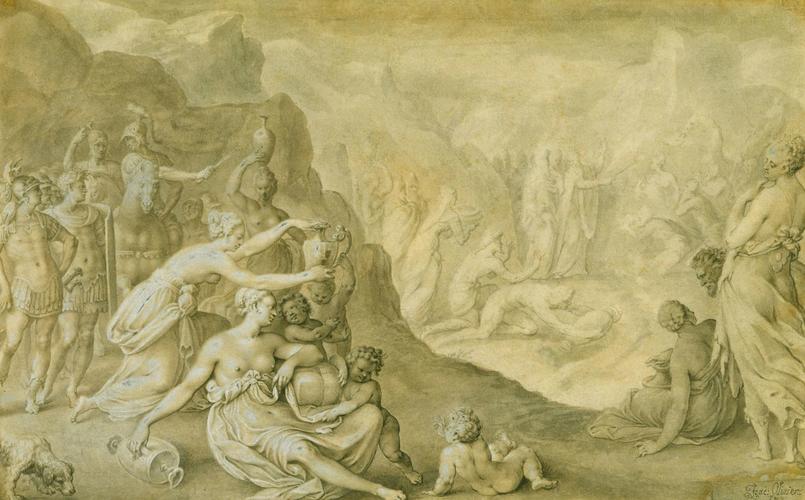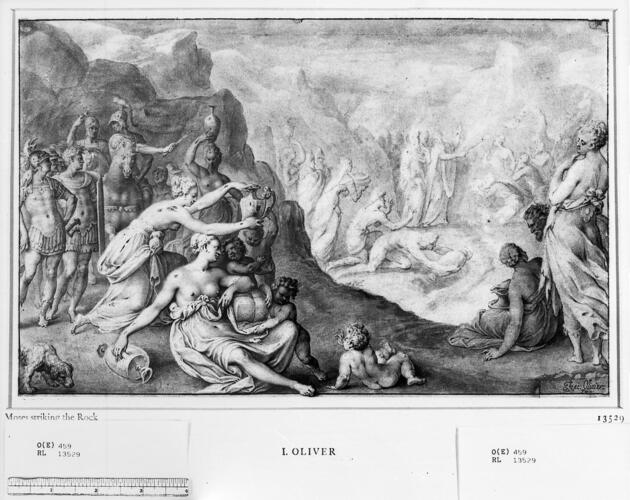-
1 of 253523 objects
Moses striking the rock c.1600
Pen and ink, brush and ink, with wash and white bodycolour | 21.0 x 33.3 cm (sheet of paper) | RCIN 913529
-
A drawing with a faint figure of Moses, at centre right, surrounded by kneeling onlookers. Female figures with infants are in the foreground on either side; a seated woman is at the centre and armoured horsemen at far left.
Isaac Oliver came to London as a child with his goldsmith father, a Huguenot refugee from Rouen, and trained as a portrait miniaturist with Nicholas Hilliard (1547-1619), the leading practitioner of that art at the court of Elizabeth I. Oliver also made a number of carefully finished and signed drawings, such as this depiction of an episode during the journeying of the Israelites, when on God’s instruction Moses struck a rock with his staff to draw forth water.
Oliver’s figure style and strong tonal values were primarily derived from Dutch Mannerists such as Joachim Wtewael (1566-1638) and Abraham Bloemart (1564-1651), through their prints and perhaps through a trip to the Netherlands. He exploited the familiar Mannerist device of placing the main action in the distance, framed by a variety of posed figures, as in Bloemart’s treatment of the same subject in a painting of 1596 (New York, Metropolitan Museum of Art). Oliver visited Venice in that year and may conceivably have passed through Utrecht en route and seen Bloemart’s painting, though this must remain a very tenuous hypothesis. Strong pointed to the distinctly French style of the figure types and decorative details in this drawing, suggesting that Oliver had had first-hand knowledge of the Fontainebleau school during a putative trip to the Continent before he trained with Hilliard, and that this drawing should thus be dated to the start of his career. But it cannot be described as ‘by far the most tentative’ of Oliver’s drawings; the foot of the central reclining woman overlapping the drawn framing line is a subtle and confident visual joke, and while French influence is clearly present, to suppose a sequence of discrete stylistic phases is to underestimate the artist’s sophistication. There is, ultimately, little evidence on which to construct a chronology of Oliver’s drawings.
Oliver’s openness to a variety of modish European influences allowed him to surpass the limited (if accomplished) style of Hilliard and brought him to pre-eminence at the cosmopolitan Jacobean court. He was appointed to the household of James I’s consort, Anne of Denmark, in 1605, and was close to the circle of her short-lived son Henry, Prince of Wales; but no drawing (rather than limning) by Oliver is documented in the Royal Collection until c.1687-8, during the reign of James II, when this drawing was recorded apparently framed and hanging in a cabinet room at Whitehall: ‘102. Isaac Oliver. A Drawing black, and white - Journying with the Children of Israell.’ Prolonged exposure to light has caused the brown ink to fade, but not the black, exaggerating the contrasts in the foreground figures.
Signed on an inset, lower right Isac: Oliuier / Fe.:
Text adapted from Holbein to Hockney: Drawings from the Royal CollectionProvenance
Royal Collection by c.1687-8
-
Creator(s)
-
Medium and techniques
Pen and ink, brush and ink, with wash and white bodycolour
Measurements
21.0 x 33.3 cm (sheet of paper)
Category
Object type(s)
Other number(s)
RL 13529

